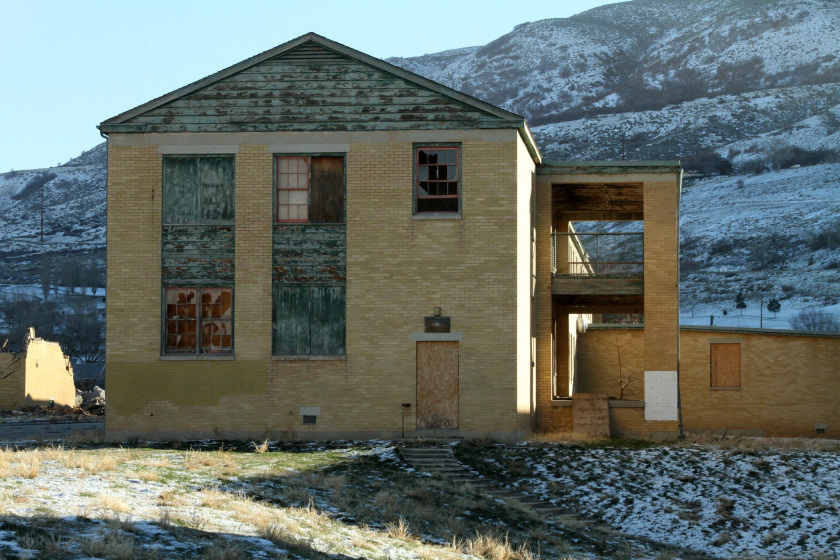When I was three years old, I began attending the Migrant Head Start preschool in Brigham City, Utah. The preschool was in good shape, but it was surrounded by forty or so other buildings that were abandoned, in disrepair, and otherwise inhospitable.
“What happened here?” I once asked.
Neither of my teachers could provide an accurate response. They stumbled over answers like, “People lived here a long time ago, and then there was a big war, and then they all had to leave,” or, “Este lugar era para los indios.” This place was for the Native Americans.
In 1950, the Bureau of Indian Affairs opened the Intermountain Indian School in Brigham City, sixty miles north of Salt Lake City and just beyond the northeastern reaches of the Great Salt Lake. The federal facility previously housed the Bushnell General Military Hospital, which served soldiers wounded in World War II. Intermountain housed only Navajo students in its first twenty years, providing primary through high school education. Many spoke almost no English, only Navajo. Facing closure in the late 1960s, the school invited students from any Native Nation, accepting students who were at least a quarter Native.
By 1975, the newly named Intermountain Inter-Tribal High School had become the largest boarding school in the world, housing more than 3,000 students from nearly 100 different tribes at its peak. After the school closed in 1984 due to budget cuts, Brigham City tried several times to purchase the property from the federal government but could not find a suitable institution to fill the extensive space. As years passed, private developers purchased the property in pieces, demolishing or gutting several buildings and turning them into a preschool, townhomes, several commercial buildings, and a golf course.

As the buildings were demolished, several private developers found remnants of Intermountain school life and donated these pieces of history to the Brigham City Museum of Art & History. However, years of misuse and weather damage left most of Intermountain beyond repair. Utah State University (USU) purchased the property in 2012, and while several attempts were made to save the remaining artifacts, most had long been destroyed.
Both USU and developers tried to salvage what were arguably the most dynamic objects: murals painted on the hallways by Intermountain students. Many were destroyed in the process, unable to be removed from the plaster walls. Shortly after USU purchased the property, several of the remaining buildings were razed, leaving photographs as the only evidence of the Intermountain art program and its rather progressive ideology—one that embraced and encouraged the students’ knowledge of their Native culture.
What originally drew me to the landscape was the disuse of the property. In many ways, I feel like the disuse held as much information about the land as the school or hospital. As I grew older, I tried to research the school’s history; however, there wasn’t much to go on. Every rock I overturned revealed nothing and left me with more questions than answers. In junior high, I asked my Utah history teacher about the property, but she couldn’t give me answers. In high school, I asked my honors English teacher about it after we read a book about a Native boarding school, but he couldn’t give me answers either.
“Well, I remember a lot of buses coming around August, and then there would be a lot of young Native Americans around town,” he recalled. “Then they would leave in May. We never went into their area, though. That was off limits.”
Brigham City residents who were not directly affiliated with the school rarely entered the property. An invisible barrier became visible when the school closed, and government officials paid workers to board every point of entry and nail “No Trespassing” signs on each building. When it became clear nobody would be able to tell me about Intermountain, I crossed the barrier and crawled in through a broken window in search of information that was not available for me anywhere else.
As I was walking down a dark hallway, I saw a mural that made me stop.

Until then, I had never thought of Intermountain as a hospitable place. However, this mural provided evidence of a once-thriving school with engaged students. The revelation reignited my childhood curiosity. As I walked down the hall, I thought about the countless days I had begged my parents to drive through the property, evenings I had walked the perimeter as a teenager, and the hours I spent in the Native American section at the library. Still, nothing was as informative or beautiful as that mural.
After I moved away from Brigham City to attend college, I assumed my time with Intermountain was over. However, a field trip to USU’s Special Collections and Archives led me to a map of the property, and for the first time I saw Intermountain in all its glory. Since that day, I have worked with former students and faculty to help preserve the history of the school. Most recently, my master’s thesis focuses on how Intermountain’s art program stood as a progressive development among the dark history of residential boarding schools. With this, I hope to finally answer the questions from so long ago.
CJ Guaddarama is a PhD student in folklore at Memorial University of Newfoundland. In 2018 he participated as a virtual intern in the Center for Folklife and Cultural Heritage’s cultural exchange project, Communities Connecting Heritage, a U.S. State Department initiative administered by World Learning. This article originally published on the project’s blog.


